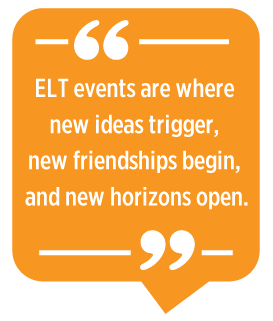|

Training and development seem to be the two most intertwined terms in
the field of teacher education. Baecher
(2021) argues that professional development is a more relevant concept in
teacher education than training for a number of reasons, but in part because
training ends while professional development continues and is concerned with
goals, learning, and the future. We have all seen teachers, all over the
world, who passionately attend preservice courses but are left unsupported
afterward. These teachers are not ready enough to face all the difficulties
during their teaching career and, therefore, give it up. Teacher
burnout, a widespread phenomenon among all teachers, is rooted in this
process.
As the name
of professional development suggests, it is a continuous practice that never
ends; if it does, the teacher ends their own professional path by being
demotivated, disappointed, dismantled, and unwanted. To avoid this, continuous
professional development is a must. This article suggests six tips for
successful continuous professional development in English language teaching
(ELT).
1. Always Be a Learner
Teachers who
forget about their learning history cannot understand their learners’ wants,
needs, and rights. Being in someone else’s shoes is one of the most practical
ways of empathizing with them. So, taking up a new hobby, such as a new
language, musical instrument, or sport can act as ways of engaging ourselves
with the learning environment. This can help us as teachers to see the world
from a learner’s lens and remind us of the challenges our learners go through.
For example, actually encountering negative feedback from the teacher of a new
class we take can have a more tangible impact than reading a lot of books about
how detrimental such feedback can be.
2. Be Positive and Surround Yourself With Positive People
In all
professions, one of the reasons for disappointment, lack of progress, and
burnout is being surrounded by negative people; teaching is no exception. We
have all seen people who see the glass as half empty and are a source of
discouragement. Avoid these people because they do not let you flourish, and
also remember not to be a source of discouragement for anyone else.
 Foord
(2009), in condemnation of the negative teachers who incessantly complain about
their institutions, classes, and relationships, calls the teacher’s room the community of mourners. Although I do not agree with the
name, collaborative nagging cannot add anything to our knowledge as teachers
and can only produce negative attitudes; I’m fond of the saying: A negative
attitude is like a flat tire; you can’t get anywhere unless you change it. Foord
(2009), in condemnation of the negative teachers who incessantly complain about
their institutions, classes, and relationships, calls the teacher’s room the community of mourners. Although I do not agree with the
name, collaborative nagging cannot add anything to our knowledge as teachers
and can only produce negative attitudes; I’m fond of the saying: A negative
attitude is like a flat tire; you can’t get anywhere unless you change it.
3. Attend ELT Events
ELT events,
such as conferences, symposiums, and courses, are not only events that start
and end on specific dates—they can mean the beginning of projects, research,
innovations, and inventions. Attending the events, we can meet new peers, get
ideas for research, find solutions to our overwhelming problems, and share
concerns and difficulties.
These events
are places for finding people who have a lot in common with you, a community of
practice. They are where new ideas trigger, new friendships begin, and new
horizons open. Thanks to the pandemic, a lot of these events are online, and
people can attend them from the comfort of their homes. Although being at an
event and meeting people face-to-face is a far more enjoyable activity, online
events provide an opportunity for teachers from underresourced organizations
and countries to benefit from such gatherings.
4. Observe and Be Observed
What we can
learn from observing a colleague is indisputable. Because teaching is a
performance-based skill, seeing others in action can give us many ideas to use
in our own practice, or it can spark new ideas. In addition, being observed can
make us see our own classrooms from another person’s eyes, and it can lead to
invaluable reflection; they can see the parts of our teaching we are blind to.
According to the Johari
window, this part of us is called the blind
self: the part of our identity, personality, or behavior that is
unknown to us but known to others. Being observed can help us open our eyes to
problems we cannot recognize but others can.
5. Reflect on What You Do
Based on
Schön’s (1987) ideas on reflection, there are three types of reflection:
-
Reflection-for-action:
Thinking about an event like classroom teaching beforehand. For example,
writing a lesson plan can be considered as this type of reflection.
-
Reflection-in-action: This type of reflection covers all the instant, intuitive
thinking a teacher does in a classroom during teaching. As teachers who deal
with unpredictable creatures (human beings), this type of quick decision-making
in the heat of a moment is a necessary skill for us.
-
Reflection-on-action:
The most well-known type of reflection, this is the one that happens after an
event like classroom teaching when a teacher considers what has happened.
All three
types of reflection can help teachers develop professionally and become
critical individuals who do not just accept ideas but critically reflect upon
them. To be able to be a reflective teacher, we first need to gather data. For
this, we need to familiarize ourselves with data collection procedures in
reflective teaching, such as questionnaires, interviews, action research, and
the like. Then, we need to insert it into our daily routine by, for example,
writing in a teaching diary every night before sleep.

6. Read, Read, and Write
I have two reads and one write in this tip to
emphasize that you should read twice what you write. Bear in mind that reading
(without writing) can keep you at the level of a recipient of the knowledge. To
get to the next level of professional development, you should enter the world
of producing knowledge and not just consuming it. Write teaching diaries,
personal blogs, magazine articles, and anything else that can help you think
critically about your teaching issues. Share them with others, have them
reviewed, receive feedback, apply the feedback, and create a network of people
who care about your writing.
Conclusion
As I’ve
argued elsewhere,
professional development is not easy and sometimes even painful (Kamali, 2021);
however, it is the only way to thrive and flourish in any profession. The tips
in this article are only some of the ways we can continue our journey on the
professional development path.
References
Baecher, L.
(2021, May 28). Why use the term “Professional Development” and not “Training”? TESOL Blog.http://blog.tesol.org/why-use-the-term-professional-development-and-not-training
Foord, D.
(2009). The developing teacher: Practical activities for professional
development. Delta.
Kamali, J.
(2021, April 9). Rumi in the language classroom: The pain of professional
development. Language
Magazine. https://www.languagemagazine.com/2021/04/09/rumi-in-the-language-classroom-vol-5-the-pain-of-professional-development
Schön, D. A.
(1987). Educating the reflective practitioner: Toward a new design
for teaching and learning in the professions. Jossey-Bass.
Jaber Kamali holds a PhD in TEFL from Allameh Tabataba’i University and DELTA from Cambridge. He is a researcher at the Applied Linguistics Research Center of Azad University, Roudehen Branch and visiting professor at Farhangian University—a specialized university for teacher education—and has been a lead trainer for different TESOL/TEFL providers. Being a researcher for almost 15 years, he has published a number of articles in scholarly journals and presented in different conferences worldwide.
|